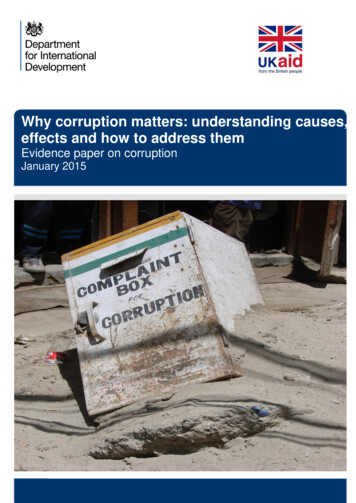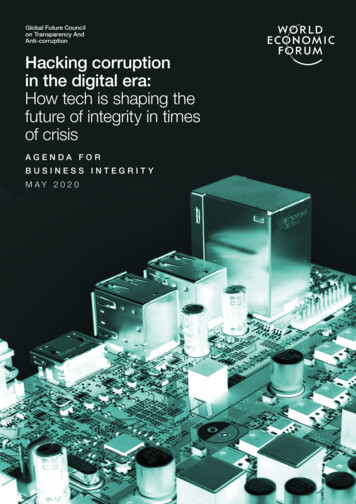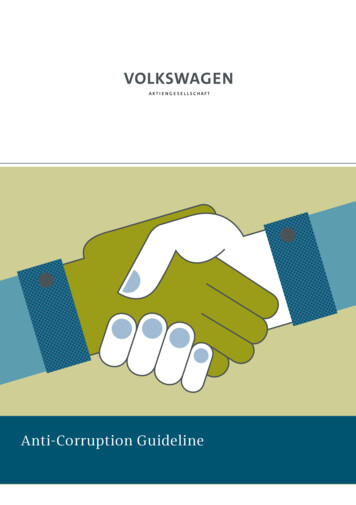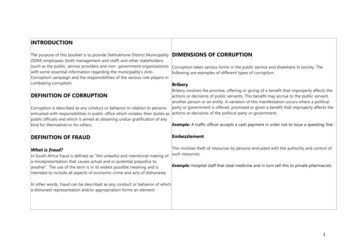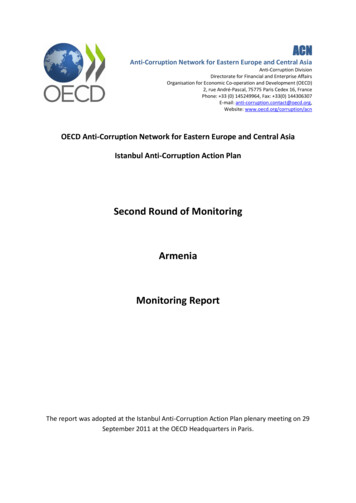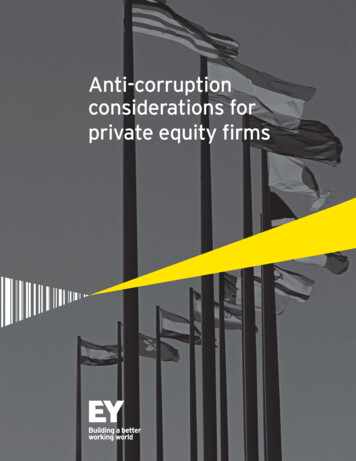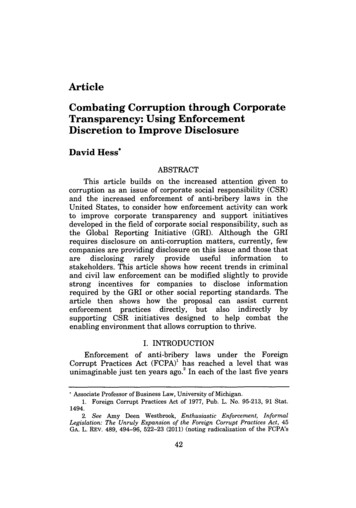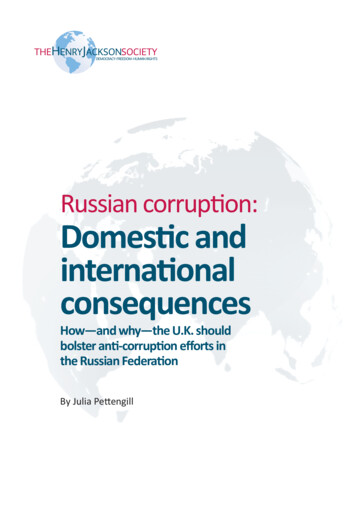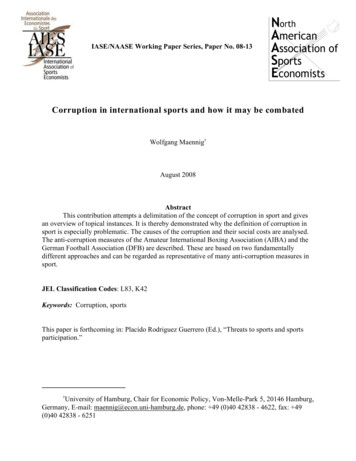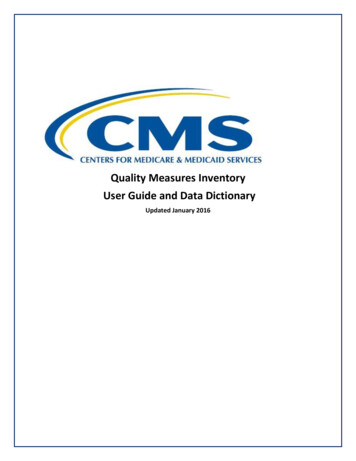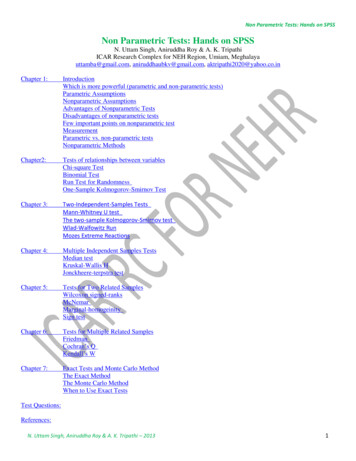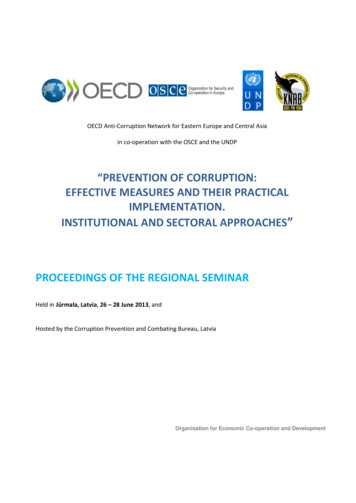
Transcription
OECD Anti-Corruption Network for Eastern Europe and Central Asiain co-operation with the OSCE and the UNDP“PREVENTION OF CORRUPTION:EFFECTIVE MEASURES AND THEIR PRACTICALIMPLEMENTATION.INSTITUTIONAL AND SECTORAL APPROACHES”PROCEEDINGS OF THE REGIONAL SEMINARHeld in Jūrmala, Latvia, 26 – 28 June 2013, andHosted by the Corruption Prevention and Combating Bureau, LatviaOrganisation for Economic Co-operation and Development
ANTI-CORRUPTION NETWORK FOR EASTERN EUROPE AND CENTRAL ASIAThe Anti-Corruption Network for Eastern Europe and Central Asia (ACN) was established in 1998 tosupport its members in their fight against corruption by providing a regional forum for promotion of anticorruption activities, exchange of information, elaboration of best practices and donor coordination.ACN is open for countries in Central, Eastern and South Eastern Europe, Caucasus and Central Asia. TheOECD and EU members, international organisations, multilateral development banks, civil society andbusiness associations also participate in its activities.The ACN Secretariat is based at the OECD Anti-Corruption Division. The Secretariat is guided by the ACNSteering Group and reports to the OECD Working Group on Bribery. OECD 2013You can copy, download or print OECD content for your own use, and you can include excerpts from OECD publications, databases and multimedia products in your own documents,presentations, blogs, websites and teaching materials, provided that suitable acknowledgement of OECD as source and copyright owner is given. All requests for public or commercial use andtranslation rights should be submitted to rights@oecd.org. Requests for permission to photocopy portions of this material for public or commercial use shall be addressed directly to the CopyrightClearance Center (CCC) at info@copyright.com or the Centre français d’exploitation du droit de copie (CFC) at contact@cfcopies.com.2
This seminar was made possible thanks to voluntary contributions provided to the ACN Work Programmeby the United States, Switzerland and the United Kingdom, as well as financial contributions made by theOSCE and the UNDP.3
TABLE OF CONTENTSINTRODUCTION. 5SUMMARY OF DISCUSSION . 7SESSION 1: MEASURES AND TOOLS TO PREVENT CORRUPTION AND THEIR EFFECTIVE IMPLEMENTATION16Estonian Anti-Corruption Policy. 17Development and Implementation of the Anti-Corruption Measures: Experience in the RussianFederation . 21Applying the Integrity Concept in Romania: National Integrity Agency s Experience and Practice . 26Measures and Tools to Prevent Corruption and their Effective Implementation . 36SESSION 2: CORRUPTION RISK MANAGEMENT AND INTEGRITY PLANS AT INSTITUTIONAL AND SECTORLEVEL . 42Integrity plans: a comprehensive tool for corruption prevention, strengthening the rule of law andintegrity of public sector . 43Managing corruption risks in Lithuania . 46SAINT: Risk Assessment Methodology in Netherlands . 57SESSION 3: PREVENTING CORRUPTION AND INCREASING TRANSPARENCY IN MANAGING ANDALLOCATING PUBLIC RESOURCES. 63Transparency: United States Government Processes. 64Prevention of Corruption in Public Procurement . 75Role of Supreme Audit Institution in Prevention of Corruption in Latvia. 83SESSION 4: PREVENTING CORRUPTION IN EDUCATION AND IN THE HEALTH SECTOR . 88Preventing Corruption in the Education Sector in Georgia . 89Strengthening Integrity in Education System in Serbia . 99Preventing Corruption in Health Sector in Latvia . 103Preventing corruption in the Romanian health system . 115AGENDA OF THE SEMINAR . 127AGENDA OF THE BACK-TO-BACK WORKSHOP. 132LIST OF PARTICIPANTS . 1344
INTRODUCTIONThe seminar “Prevention of Corruption: Effective Measures and their Practical Implementation.Institutional and Sectoral Approaches” took place on 26 – 27 June 2013 in Jūrmala, Latvia. A workshop forCentral Asian countries “Asset Declarations and Prevention of Conflicts of Interest: Effective Tools toPrevent Corruption in Central Asia” was organized back-to-back on 28 June 2013.The event was hosted by the Corruption Prevention and Combating Bureau of Latvia and organised by theOECD Anti-Corruption Network for Eastern Europe and Central Asia (ACN) together with the Office of theCo-ordinator of OSCE Economic and Environmental Activities and the UNDP Bratislava Regional Centre.The seminar and the back-to-back workshop brought together 65 participants representing 23 countries,including Albania, Azerbaijan, Bosnia and Herzegovina, Croatia, Estonia, former Yugoslav Republic ofMacedonia, Netherlands, Georgia, Kazakhstan, Kyrgyzstan, Latvia, Lithuania, Moldova, Mongolia,Montenegro, Romania, Russian Federation, Serbia, Slovenia, Tajikistan, Turkmenistan, Ukraine, theUnited States and Uzbekistan and OECD, OSCE and UNDP. The list of participants is attached.This seminar focused on the following topics: Measures and tools to prevent corruption and their effective implementation;Corruption risk management and integrity plans at institutional and sector level;Preventing corruption and increasing transparency in managing and allocating public resources;Preventing corruption in education and health care.The seminar provided a forum for mutual learning, sharing experiences and good practice on preventionof corruption among Eastern European and Central Asian and other countries. The seminar helped toidentify common trends, challenges and solutions, in particular to enhance practical implementation andachieve concrete results on the ground. The seminar combined presentations, round-table discussionsand working in groups.These proceedings contain a summary of discussion, the presentations made during the seminar, asummary of the agenda and the list of participants.5
6
SUMMARY OF DISCUSSIONMr. Jaroslavs Streļčenoks, Director, Corruption Prevention and Combating Bureau, Latvia together withMs. Annie Demirjan, Democratic Governance Practice Leader, UNDP Bratislava Regional Centre, Dr. HalilYurdakul Yigitgüden, Co-ordinator of OSCE Economic and Environmental Activities, and Ms. Olga Savran,Manager of the OECD Anti-Corruption Network for Eastern Europe and Central Asiaopenedtheseminar.Session 1: Measures and tools to prevent corruption and their effective implementationThis first introductory session was dedicated to approaches and tools to prevent corruption and waschaired by Mr. Jaroslavs Streļčenoks and Ms. Olga Savran. The session included five presentations and adiscussion.Mr. Goran Klemenčič, Chairman of the Independent Commission for the Prevention of Corruption inSlovenia highlighted that many formally many requirements to prevent corruption are in place, but theylack effective enforcement. He outlined that an “anti-corruption bureaucracy” has been created and thatvarious networks, conferences and action plans are regularly dedicated to this issue, but the time is nowto ask what really works in a particular country. Mr. Klemenčič brought the example of how the legalframework for asset disclosure for public officials existed in Slovenia for 20 years and that only recentlythe Independent Commission for the Prevention of Corruption used this information and gatheredevidence on suspicious acquisition of unexplained wealth by some influential public officials in Slovenia,for example, the Prime Minister and the major of the capital city. Since the Commission does not havepowers to impose sanctions, the evidence gathered was submitted to the court and the Commission wonthe case. Following that, asset declarations are taken more seriously in Slovenia and many officials havesubmitted corrected asset declarations. Further, Mr. Klemenčič presented the “Supervizor”, an on-linedaily updated data base of all financial flows at state, local and regional levels (all transactions registeredby the authority of public payments). It was developed by the Independent Commission for thePrevention of Corruption. Today it is a widely used tool in Slovenia. In 2013, the “Supervizor” won the UNPublic Service Award for this initiative. Mr. Klemenčič emphasised that this data base has empoweredcitizens, in particular at local level, where complaints of citizens have led to annulment of numerouscontracts concluded by local councils.Ms. Mari-Liis Sööt, Head of Analytical Division, Criminal Policy Department, Ministry of Justice in Estoniadiscussed the new anti-corruption action plan in Estonia, which focuses on “indirect” or preventivemeasures to fight corruption. The priorities of the strategy are healthcare, education and transparency indecision-making. Similar to Slovenia, Estonia also wants to disclose more public information, including onfinancial flows at the level of municipalities and between private and public sectors, public procurement,planning and various registers. Ms. Sööt outlined the “decentralised approach” to anti-corruption work inEstonia, based on a rather small central capacity and focusing on forming sectoral anti-corruptionnetworks, for example, in healthcare, law enforcement, local governments or education and creation ofanti-corruption co-ordinators in line ministries. They participate in developing anti-corruption measuresand assess their implementation. Also, Ms. Sööt emphasised the need to work more with academics andpractitioners and the lack of research on the application of corruption prevention tools, for example, the7
asset declarations. Ms. Sööt noted that it would be useful to exchange experience with other countrieson how to measure performance in the area of corruption prevention.Mr. Valery Korchagin, Head of the Financial Policy Division, Ministry of Foreign Affairs, RussianFederation, highlighted the importance to develop a systematic approach to fighting corruption includingpreventing corruption, investigating and prosecuting corruption crimes and limiting corruptionconsequences. Mr. Korchagin presented the policy, legal and institutional framework for fightingcorruption in the Russian Federation. He noted that institutional anti-corruption plans are developed inall federal level institutions, based on a template and they are all available on the Internet. Mr. Korchaginstressed that the anti-corruption policy is based on three priorities: developing an appropriate legal andinstitutional framework; creating a mechanism to enforce anti-corruption legislation and create suchenvironment, in which corruption would be a risk; and ensuring application of anti-corruption rules by thecitizens, including use of repressive means, if needed. Mr. Korchagin underlined that the mechanism toprevent corruption in the Russian Federation is mainly aimed to ensure that corruption becomes aninappropriate and disadvantageous behaviour. Mr. Korchagin listed means existing in the RussianFederation to prevent corruption: special corruption prevention units in public institutions; disclosure ofincome, expenditure and property by public officials at state and municipal levels, high level officials instate corporations, the national bank and their family members; regular control of application of differentbans and restrictions for public officials; anti-corruption expertise of legal acts; creation of a mechanismto manage conflicts of interest; post-public employment restrictions; gifts policy; ban to public officials totravel abroad using funding of other persons, ban to hold accounts, securities and other financialinstruments in foreign countries and other preventive means.Ms. Gianina Chirazi, Counsellor at the Communication, Public Relations and Strategy Department,National Integrity Agency in Romania, presented the National Integrity Agency (ANI) and results of itswork in the field of verification of assets, conflict of interest and incompatibilities of public officials inRomania. Ms. Chirazi highlighted the results of ANI’s work. For example, several Members of Parliament,a Deputy Secretary General of the Government, three Ministers to-be-appointed, mayors, Presidents andVice-Presidents of county councils, but also police officers, judges, prosecutors had to resign or were notappointed following ANI’s findings. Ms. Chirazi explained that the cases are investigated by 33 integrityinspectors, and the work is organised using an integrated electronic data base for asset and interestdeclarations and an electronic document management system. Over 3,86 million disclosure formssubmitted to ANI in 2008 – 2012 are publicly available on the portal http://declaratii.integritate.eu.Mr. Vladan Joksimović, Deputy Director of the Anti-Corruption Agency of Serbia discussed the experiencein Serbia related to integrity plans in the public sector, analysis of corruption risks in the legislation, anticorruption research and anti-corruption educational programs. Mr. Joksimović highlighted as a keydevelopment the introduction of the integrity plans in the Serbian public sector. The Anti-CorruptionAgency played a key role in providing methodological support, in form of education, advice and varioussupporting documents, such as models of integrity plans, a guide in the process of its development andintegrity plan development manuals. While that there are no sanctions foreseen for failing to do so,almost half of public institutions concerned had developed an integrity plan in Serbia by March 2013. Inthe future, the Anti-Corruption Agency intends to monitor the implementation of these plans.During the discussion participants agreed that focusing on corruption in specific sectors could be anefficient way to prevent it. The importance to prioritise the work of anti-corruption authorities wasemphasised. It is key to look more at what is really important and to better use the entrusted mandatesin order to expose acute corruption problems and promote change. For example, the Independent8
Commission for the Prevention of Corruption in Slovenia studied the causes and the functioning ofcorruption in the health sector and explained it in a report, which was made public and generated adebate, leading to some changes in the system. Academic research could give useful insights as to whatworks to prevent corruption, especially in a long run. Participants agreed that an anti-corruptionbureaucracy has been created over the years. While anti-corruption action plans are useful to organisethe anti-corruption work, they often remain a formality. Rather more accent should be put onresponsibility of individual ministers and heads of public institutions, a network of contact persons andgood co-ordination. Participants noted that informal networks can be more efficient than hierarchicalstructures. Also, participants noted the challenge how to monitor performance, measure results andassess impact of the efforts to prevent corruption. The importance of public trust was highlighted. It wasalso emphasised that it may be worthwhile to separate corruption prevention and enforcementprogrammes. Only a preventive body will be asked to provide advice without fear of being prosecuted.Viable, self-respected civil service and a good human resources policy in the civil service are key toprevent corruption. The importance of exposing irregularities was outlined, but also the need to “whitelist” public officials who, after checking, appear not to be corrupt. In the area of asset declarations, thediscussion focused on the importance of their verification and different approaches to it, varying fromchecking the declarations upon receipt of a complaint to checking only the declarations of risk groups.Session 2: Corruption risk management and integrity plans at institutional and sector levelThe second session was dedicated to risk management and integrity plans in public institutions and atsectoral level. It was chaired by Ms. Mari-Liis Sööt and Ms. Nina Lindroos-Kopolo, Head of the EconomicGovernance Unit, Office of the Co-ordinator of OSCE Economic and Environmental Activities. The sessionincluded three presentations and a discussion.Mr. Goran Klemenčič presented the experience in Slovenia in introducing integrity plans in the publicsector. He explained that integrity plans contain an assessment of corruption risks and other risks ofunlawful or unethical behaviour in the institution, as well as proposals to improve integrity and preventcorruption. In order to support their development, the Independent Commission for the Prevention ofCorruption provided guidance and training, explaining what the risk assessment is. Approximately 1700out of 1900 expected integrity plans were submitted. Mr. Klemenčič emphasised the key role of theinternalisation of the integrity plan by employees and heads of each public institution rather thanimposing them from outside. It is key that sector specialists identify the risks in their institutionsthemselves. Also, Mr. Klemenčič emphasised that integrity plans are a process and require constantmonitoring and improvements. Integrity plans can be useful in different ways: investigating concretecases; assessing corruption risks in the country, etc.Mr. Vidmantas Mečkauskas, Head of the Corruption Risk Division, Corruption Prevention Department ofthe Special Investigation Service (STT) in Lithuania, described how corruption risks are assessed inLithuania. Mr. Mečkauskas presented the legal and regulatory basis and the process of risk analysis inpublic and municipal institutions in Lithuania. Mr. Mečkauskas discussed different stages of this process.First, public and municipal institutions analyse corruption risk areas in their work and how they areaddressed, and prepare a motivated conclusion, which is presented to the Minister or mayor and thensent to the STT. Then the STT analyse the corruption risks presented and prepare recommendations.These recommendations can be sent to the specific public institution and to the responsible ministry.Further, in 3 months’ time the responsible public or municipal institution present the STT an update onthe implementation of the recommendations. Mr. Mečkauskas also presented a useful list of generic9
criteria used in Lithuania to determine whether a certain institution, post or function can entailcorruption risks.Mr. Alain Hoekstra, Coordinating Policy advisor of the National Integrity Office in Netherlands presentedthe corruption risk self-assessment methodology (SAINT) in Netherlands. According to the Civil ServantsAct, the risks assessments are mandatory in Netherlands. SAINT includes determination of the mostvulnerable processes to corruption and the key integrity risks, the assessment of how strong the integrityframework is in the institution to deal with these risks and a gap analysis of what can be improved. Mr.Hoekstra presented several concrete examples of processes in public institutions, which are vulnerable tocorruption, and examples of possible hard, soft and general control tools. As part of SAINT process,employees of concerned institutions complete questionnaire and participate in workshops, assessing howeffectively integrity measures are put in place. Mr. Hoekstra emphasised that SAINT is a fast and cheapway to identify vulnerabilities, based on a bottom-up approach, but the managers remain responsible forthe follow-up.The discussion focused on the suitability of risk assessment methodologies to public organisationdepending on their size and type of the work. The question of how cost effective this tool is wasdiscussed. It was stressed that the actual implementation of the risk assessments is an important problemfor public institutions. Even in countries where this measure is mandatory the implementation remainslow. It was said that in such cases it may be worth returning to hard controls.Session 3: Preventing corruption and increasing transparency in managing and allocating publicresourcesThe third session focused on prevention of corruption and increasing transparency and integrity in themanagement and allocation of public resources. It was chaired by Ms. Olga Savran and Ms. NinaLindroos-Kopolo. The session included four presentations and a discussion.Ms. Barbara Fredericks, Assistant General Counsel for Administration, Office of the General Counsel fromthe Department of Commerce, discussed the traditions of openness of government in the United Statesand the benefits from it to both the public and the government. The openness helps the government tokeep public support and build trust in democratic institutions, while citizens who know understand theruling under which they live are more inclined to comply with it and it is a way for them to hold thegovernment accountable. Ms. Fredericks discussed some of the laws and institutions relevant to theopenness in government, for example, the Administrative Procedures Act, the Government in SunshineAct, the Freedom of Information Act, as well as the role of the Federal Advisory Committees. Ms.Fredericks emphasised the role of the government in proactively releasing information. Citizens in theUnited States can find ample information about activities funded by the government and track publicspending. Information of some administrations, for example, the US Food and Drugs Administration, isvery popular and millions of citizens daily visit their website. The current Administration in the UnitedStates moves towards more transparency of information and continues to expand the number ofdocuments released before any request is made. Ms. Fredericks emphasised that the more information isreleased the more confidence the public has in government decision making. It has also resulted in lessindividual requests to government agencies, savings resources in responding to individual request fordocuments. Also personal assets of high level officials are disclosed in the United States. Ms. Frederickssaid that for transparency to be useful there should be demanding and vigilant citizens and media.10
Ms. Đinita Fočo, Director of the Public Procurement Agency in Bosnia and Herzegovina, discussed therisks of corruption in public procurement. Ms. Fočo mentioned among key risks the link between politicalcorruption and public procurement, bribery and extortion that occur at lower levels of decision-making,conflicts of interest of members of procurement commissions and misuse of emergency procedures. Ms.Fočo stressed that it remains difficult to prove the link between corruption and public procurement.Political corruption often occurs in relation to important investment projects. Officials at lower level areoften offered not simply money, but rather receive gifts, trips, cars, etc. and ultimately improve theirlifestyle, but it remains difficult to prove the link in-between. Also, Ms. Fočo emphasised that corruptionfrequently occurs in the beginning of the procurement cycle, namely already during the elaboration ofthe technical specification, as part of the tender documentation, and then also during the realization ofthe contract. Hence, introducing e-procurement is not enough to solve corruption problems in publicprocurement. Ms. Fočo stressed the important role of investigation and audit authorities, internal audit,promoting the “four-eye principle”, sanctions, education and professionalization.Mr. Alem Dzumabekov, Department for Detecting and Preventing Corruption Cases, Agency on FightingEconomic and Corruption Crime, Kazakhstan discussed the experience in preventing corruption in the useof public resources in Kazakhstan. Mr. Dzumabekov talked about the role of internal and external control,including the work of the Financial Police, stressing that its controls are based on reports received.Ms. Marita Salgrāve, Council Member of the State Audit Office of the Republic of Latvia, stressed thatsupreme audit institutions (SAIs) are important players in prevention of corruption in public service. Theindependence of SAIs in defining audit themes and audit scope is key. The supreme audit institutionsupports the management of public resources in a manner that is proper, transparent, accountable andcorresponding to the needs of the society. The regularity of audits is a very important feature, motivatingpublic and municipal institutions to implement the recommendations. Also, an important role of SAIs isto raise public awareness of corruption and timely and public disclose audit findings. Increased publicawareness of corruption helps to foster transparency and accountability. Ms. Salgrāve also said that theState Audit Office can detect such irregularities as, for example, unjustified technical specifications in theprocurement process, favouritism towards relatives and other forms of conflict of interest or such signs ofirregularities as untransparent decisions or undue benefits given to contracting parties, however, it ismore difficult to uncover complex corruption schemes through these mainly documents-based audits. Animportant challenge is the nomination of public officials based upon political affiliation or “affiliation” of acertain ministry or state-owned enterprise to their political party. Overall, in order to prevent corruptionit is important to create an environment, which is not favouring or permitting corrupt practices, sincepoor governance provides opportunities for corruption. Moreover, it is key to build a system of values inthe society where bribery is not demanded and tolerated and such values as ethics and responsibility(accountability) are enforced.The discussion focused on the role of creating an environment, which is not conductive to corruption andthe importance of education and ethics role models. The question of internal control and reportingmechanisms within public institutions was raised. For example, the system of independent inspectorsgeneral in the United States seems to work well; the inspectors general deal with both specific reports bywhistleblowers, but also systemic problems. The role of public opinion and the possibility to veto certaindecisions was also highlighted.11
Session 4: Preventing corruption in education and in the health sectorThis session was dedicated to prevention of corruption in public education and in the health care sectors.It contained four presentations. The session was chaired by Dr. Liesma Ose, Deputy Director of the PolicyInitiatives and Development Department, Ministry of Education and Science in Latvia and Mr.Francesco Checchi from the UNDP Bratislava Regional Centre.Preventing corruption in public educationMr. Aleksandre Abashidze, Head of the Department of Internal Audit in the Ministry of Education andScience in Georgia, outlined the experience of Georgia, which is known for its major reforms in theeducation sector leading to diminishing the levels of corruption in public schools and universitiesconsiderably, but also to increasing the quality of education. Mr. Abashidze presented the main areas anddirections of reforms, such as introducing unified entrance exams, strengthening the accreditationprocess of the universities, centralising the procurement through the State Procurement Agency,Supervisory boards in public schools, transparent and centralized competition for school principals,establishing a central agency for infrastructural services for the public schools and other steps. Mr.Abashidze emphasised that most of the reforms in education sector in Georgia are related to technicalinnovations that can be implemented in other countries too. According to a Eurobarometer surveyquoted by Mr. Abashidze, in 2002, 18 per cent of the Georgian citizens believed that teachers areinvolved in bribery compared to 1 per cent in 2012.Ms. Jasmina Kostadinovic, Head of the Legal Affairs Unit in the Ministry of Education, Science andTechnology Development in Serbia, the first country, which has asked for an assessment of its educationsystem in terms of integrity. In 2012, the OECD released the report “Strengthening Integrity and FightingCorruption in Education. Serbia”, which provides an overview of integrity risks in the education system inSerbia and recommendations how to strengthen integrity and prevent corruption in this sector.1 Ms.Kostadinovic said that the OECD report sh
Federation, highlighted the importance to develop a systematic approach to fighting corruption including preventing corruption, investigating and prosecuting corruption crimes and limiting corruption consequences. Mr. Korchagin presented the policy, legal and institutional framework for fighting corruption in the Russian Federation.
